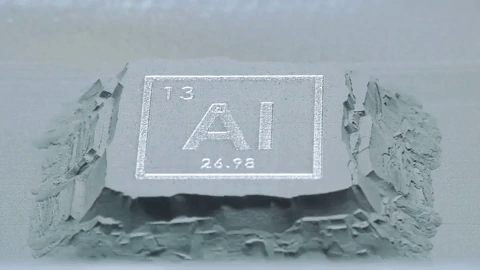
[Image above] Credit: HRL Laboratories; YouTube
Researchers have proven that just about any material can be 3-D printed. We’ve seen materials such as polymers, ceramics, glass, concrete, organ tissues, and even extraterrestrial soil go through the additive manufacturing process to create functional objects.
And now, in what appears to be the final frontier of additive manufacturing, engineers at HRL Laboratories have now achieved the impossible—3-D printing of high-strength aluminum alloys, specifically Al7075 and Al6061.
Their secret? Zirconium-based nanopowders.
In a process called nanoparticle functionalization, Hunter Martin and Brennan Yahata, engineers in HRL’s Sensors and Materials Laboratory, added “specially selected nanoparticles” to high-strength alloy powders and fed them through a 3-D printer. The printer layers the powders and fuses the layers to each other with a laser, eventually creating the final three-dimensional object.
“Of the thousands of commercially available metal alloy systems, only a handful of about 10 alloys can be readily 3-D printed,” Yahata says in a video.
Metals are ordinarily 3-D printed with alloy powders that are layered and laser-heated, which melts and solidifies the layers. But there are some metals that are unweldable, meaning they cannot stand up to the welding process without falling apart, or “hot cracking.”
And if you wanted to build an airplane with Al7075 or Al6061—two unweldable alloys that are desirable for the aircraft and automotive industries—you’d have to get out your rivet gun and start riveting.
But the nanoparticles used in the additive manufacturing process prevent hot cracking of unweldable alloys. During melting and solidification, the nanoparticles act as nucleation sites for the desired alloy microstructure, preventing hot cracking and allowing retention of full alloy strength in the manufactured part, according to HRL’s news release.
HRL researchers are also using their nanoparticle functionalization process to make other unweldable alloys weldable.
“Additive manufacturing of metals is essentially equivalent to welding,” Martin says in the video. “You’re taking layer by layer and welding each layer on top of another. So, that adds the constraint that the metals you put in there, generally have to be weldable. So what we did at HRL was we took an unweldable metal and made it weldable—so they can now be processed in conventional additive manufacturing equipment.”
It might soon be time to toss the rivet guns.
Their paper, published in Nature, is “3D printing of high-strength aluminium alloys” (DOI: 10.1038/nature23894).
Watch the video below to see the process.
Credit: HRL Laboratories; YouTube
Did you find this article interesting? Subscribe to the Ceramic Tech Today newsletter to continue to read more articles about the latest news in the ceramic and glass industry! Visit this link to get started.
